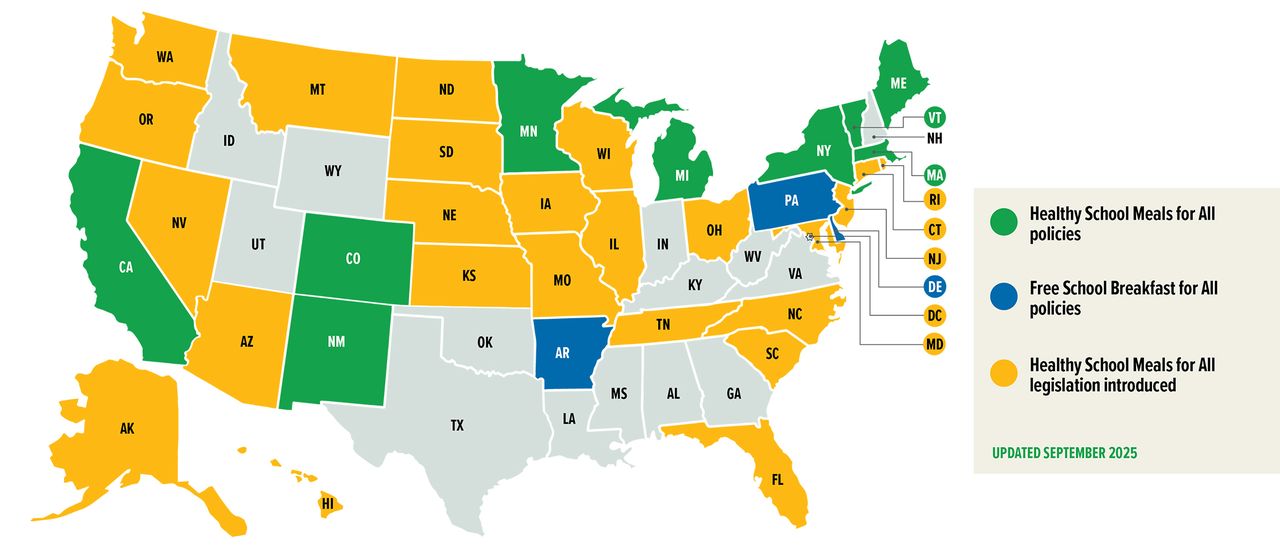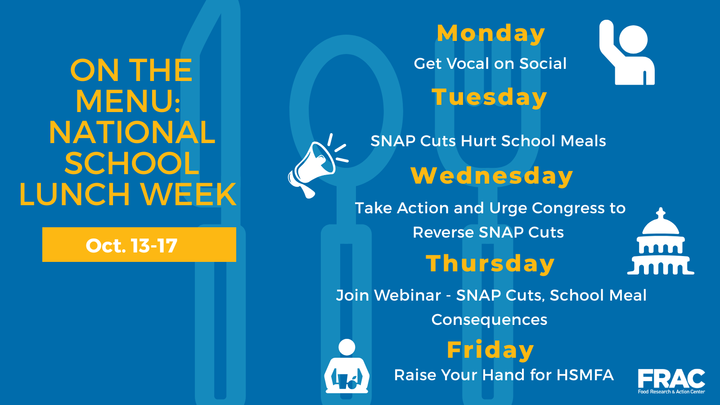October 13–17 is National School Lunch Week, a celebration highlighting the history of the National School Lunch Program and showcasing the critical role school meals play in children’s health and learning. School meals are vital public health programs, associated with improvements in students’ diet and academic achievements, and serving as an important outlet for American food and agriculture.
Participation in school lunch has grown tremendously since the passage of the National School Lunch Act in 1946. In the 2023–2024 school year, nearly 30 million children participated in school lunch every school day, a 4 percent increase from the previous school year. Much of that growth can be attributed to policies and programs that dismantle participation barriers by offering all students school meals at no charge, such as the Community Eligibility Provision (CEP) or states’ Healthy School Meals for All policies.
Community Eligibility and Healthy School Meals for All Boost School Meals Participation
CEP, which allows high-poverty schools to offer all children free school meals, has been a gamechanger for school nutrition — increasing participation in school breakfast and lunch, reducing stigma by removing the need to identify students as eligible for free or reduced-price meals based on their household income, , cutting through bureaucratic red tape, streamlining school nutrition operations, and eliminating school meal debt. In the 2024–2025 school year, over 54,000 schools in the U.S. used CEP to offer free school meals to more than 27 million children nationwide.
Healthy School Meals for All policies maximize CEP’s reach by allowing all schools to offer all students school meals at no charge. Momentum around Healthy School Meals for All has continued to build since California and Maine first passed free school meals policies in 2021. States’ Healthy School Meals for All policies leverage the federal reimbursement provided through CEP and traditional school meals programs to offset the states’ cost of subsidizing free breakfast and lunch. As of the 2025–2026 school year, nine states — California, Colorado, Maine, Massachusetts, Michigan, Minnesota, New Mexico, New York, and Vermont — have passed Healthy School Meals for All policies, bringing the benefits of free school meals to millions of children each school day.

Cuts to SNAP Hurt School Meals
The progress made with CEP and Healthy School Meals for All policies are under threat. Recently passed SNAP cuts in the budget reconciliation law (H.R. 1) jeopardize schools’ ability to implement CEP and states’ ability to fund Healthy School Meals for All and other child nutrition policies. SNAP provides a direct link between eligible children and free school meals through a process known as direct certification. The more children directly certified for free school meals, the more likely a school can implement CEP.
As children lose access to SNAP, students will lose their automatic eligibility for free school meals, and CEP schools will receive less federal reimbursement to operate the program. As federal reimbursements decrease, the cost of offering Healthy School Meals for All will shift to state budgets. Additionally, the SNAP cost shifts in H.R. 1 requiring increased program financial responsibility from states will place more strain on state budgets, threatening states’ financial ability to administer SNAP, Healthy School Meals for All, and other child nutrition policies.
Act Now to Mitigate Harm to School Meals
Join FRAC this National School Lunch Week to promote the benefits of free school meals for all and push back against the devastating cuts to SNAP that will hurt school meals and other child nutrition programs.
Check out the calendar below for opportunities to get vocal on social with FRAC’s digital toolkit.

Use the FRAC Action Network to send a message directly to your Members of Congress urging them to repeal harmful SNAP cuts and protect school meals to ensure every child grows up free from hunger.

